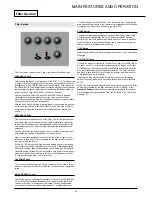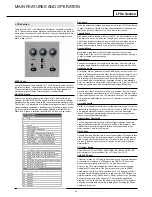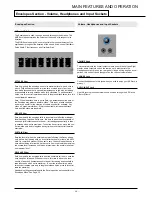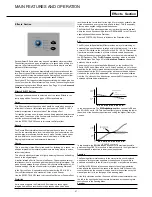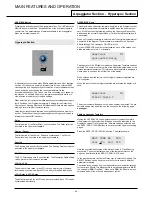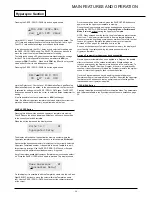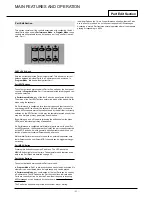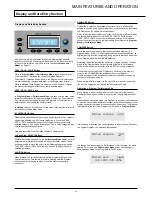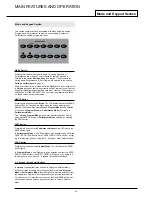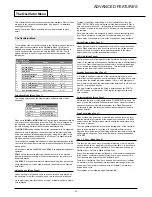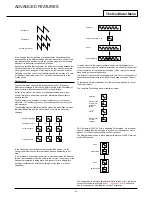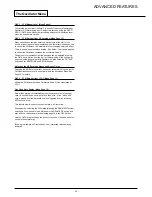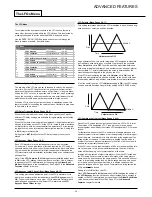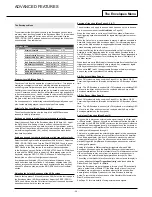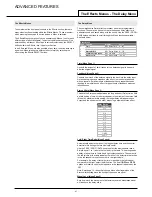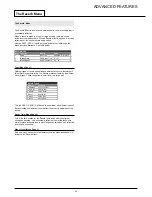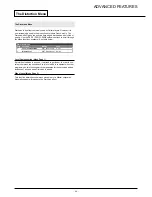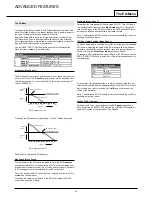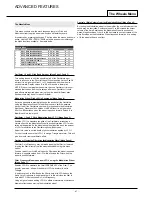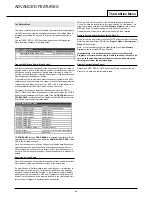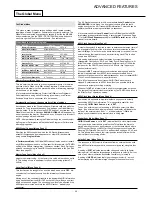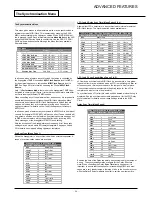
ADVANCED FEATURES
The Mixer Menu - The Filter Menu
•
37
•
The Mixer Menu
T
o complement the front panel controls in the Mixer section, there are
other functions located within the Mixer Menu. This is selected by press-
ing the keypad ‘
2
’ button while in a
Menu
.
Use the PERF / PROG / PAGE up/down buttons to scroll through the
Menu functions available - See table below.
LFO 2 Level Modulation to OSC1
LFO2 may be routed to control the level of the volume from Oscillator 2 in
the Mixer section. This is useful if timbre from OSC to be faded in and
out on a once only basis (LFO2 set to one-shot mode) or cyclically. Listen
to some of the factory presets to hear this function.
Noise
This setting determines the frequency characteristics of the Noise signal
available from the Mixer’s NOISE / RING / EXT knob. Four different types
of Noise are available.
0 - This is standard White Noise, with all frequencies present in equal
amounts.
1 - This is a high pass filtered Noise and is useful for contructing certain
types of percussion type sounds.
2 - This is a band pass filtered Noise and is also useful for contructing
certain types of percussion type sounds.
3 - This is different type of high pass filtered Noise and again it is useful
for contructing certain types of percussion type sounds.
The Filter Menu
T
o complement the front panel controls in the Filter section, there are
other functions located within the Filter Menu. This is selected by press-
ing the keypad ‘
3
’ button while the KS Rack is in
Menu Mode
.
Use the PERF / PROG / PAGE up/down buttons to scroll through the
Menu functions available - See table below.
Tracking (Menu Page 1)
This controls the amount of change to the filter Cut off (set by the FRE-
QUENCY knob) by the pitch of the note played. When the PERF / PROG
/ DATA knob is turned fully anticlockwise, there is no change to the filter
Cut off frequency. With clockwise movement there will be an increasing
amount of modulation. The filter will be opened more as higher notes are
played on the keyboard. This control is used to define how the timbre of a
sound changes over the keyboard.
At the fully clockwise position, the filter tracks the pitch changes in a 1 to
1 ratio. This means that with RESONANCE set to a high level, the pitch
of the Filter’s self - oscillation will increase in semitone steps as notes are
played on the keyboard. This effect is akin to adding an extra (Sine
Wave) Oscillator to the sound when notes are played on the keyboard.
Velocity Sensitivity (Menu Page 2)
This setting is used to modulate the Cutoff FREQUENCY of the Filter up
or down in response to the velocity information present in incoming note
messages or notes played on the keyboard.
Set in the range
-1
to
-64
, the Filter will close (the Cutoff FREQUENCY
will decrease) as velocity data is applied. With a range of
1
to
63
, the
Filter will open (the Cutoff FREQUENCY will increase) as velocity data is
applied. Greater values will open (increase the Cutoff FREQUENCY) as
velocity data is received. At a setting of
0
, note velocity will have no
effect.
Q Normalise (Menu Page 3)
This value controls the Resonance Normalise. At zero, when resonance
is applied, the main audio signal will remain at normal levels. Adjusting
clockwise will reduce the signal level in relation to the resonance level.
This feature enables the Filter to emulate many of the classic Filters such
as the Moog type, Oberheim type and Roland TB303* type.
* Trademark of the ROland Corporation of Japan
Filter Menu
Page
Function
Display
Value
1
Tracking
FILT Kbd Track
0…127
2
Velocity Sensitivity
FILT Velocity
0…127
3
Q Normalise
FILT Q Normalise
0…127
Mixer Menu
Page
Function
Display
Value
1
LFO2 Level Mod to OSC 1
MIX Osc1 L2 Lev
-64...63
2
Noise Type
Mix Noise Type
White - Band


